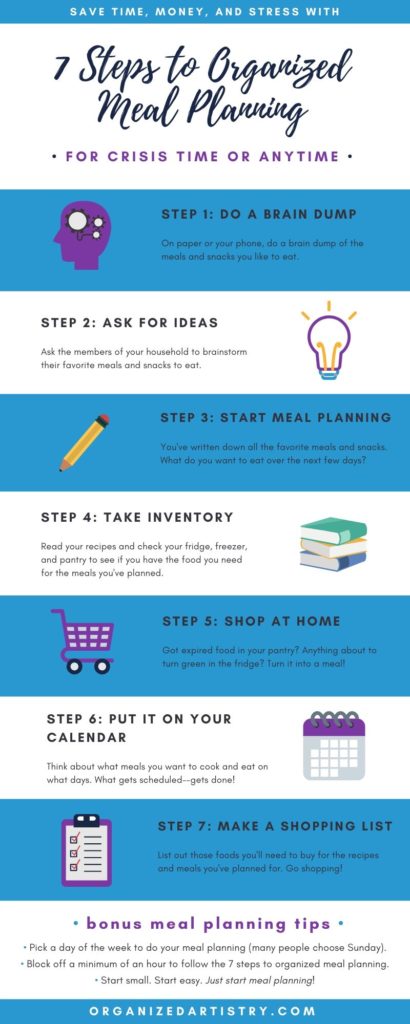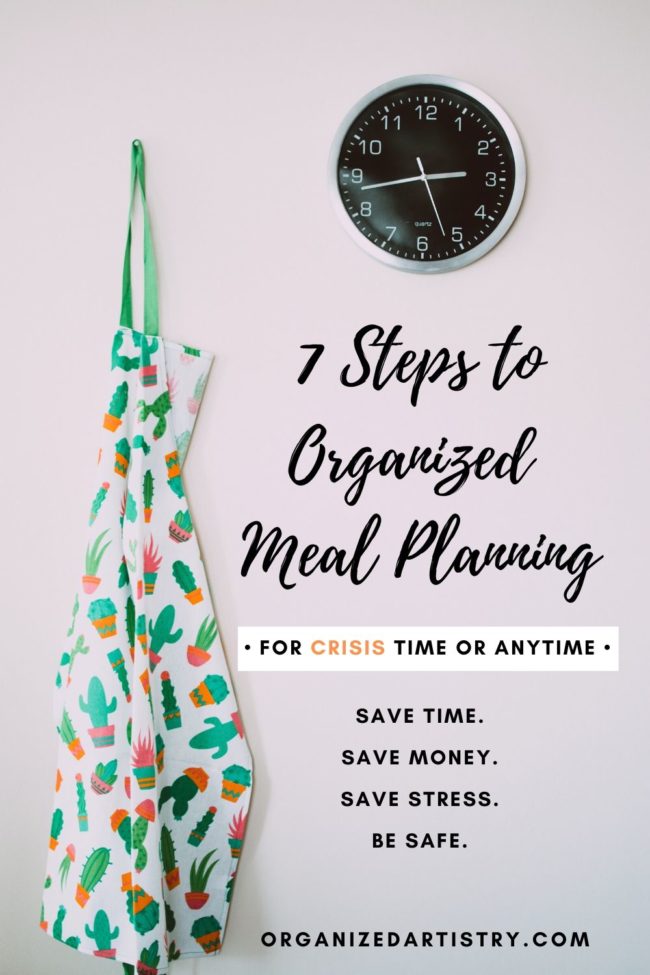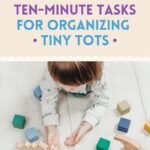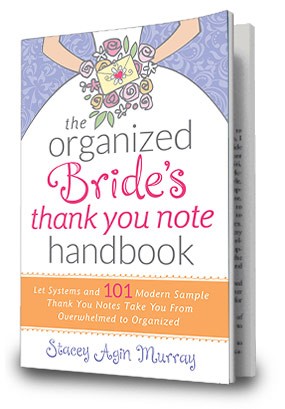I have been thinking about blogging about meal planning for a while. With the coronavirus pandemic currently a part of our everyday lives, there isn’t a better time to talk about it.
I’ve been a Professional Organizer for eighteen years. I’m also the ‘head chef’ in my family. One of the most vital organizing systems I’ve created in my home is the meal planning I do for my family.
Why do I meal plan?
I grew up with my mom planning our meals–I witnessed the benefits of planning ahead. As a single woman (an elementary school teacher living on a tight budget) I shopped, packed my own lunches, and planned dinners according to the needs of my schedule. Now, as a wife and mom, good nutrition, multiple family food allergies, and a busy lifestyle make meal planning a necessity to stay on top of our food needs.
Why is it important to meal plan?
We eat every day. Multiple times a day. To live. There’s no getting around that…
Anything we do multiple times a day, every day should have some kind of automation so we don’t have to constantly be thinking about it.
Meal Planning is a multi-step system and organizing strategy designed to take the every-day-multiple-times-a-day thought process of ‘what-are-we-going-to-eat?’ out of your head and put it onto paper or your favorite digital tool.
You want to avoid organizing your sock drawer–OK. I’ll give that to you. But, please–don’t avoid meal planning. Especially now.
Why is its important to meal plan NOW?
In the time of coronavirus, food shopping is considered an essential trip outside of your home. For safety reasons, we’re supposed to stay out of public spaces as much as possible. This is not the time to be running to the grocery store for a forgotten ingredient or because you can’t think of what to cook for dinner.
Meal planning is a time management strategy but now, it is also a safety measure that will ensure you spend as little time as possible food shopping in public. You’ll also know exactly what recipes you’ll be making, what foods you’ll be eating, and when you’ll be eating them–one less thing to think about every day when we have so many other recent lifestyle changes to juggle.
*If you currently do most or all of your food shopping online due to age, illness or personal choice, it’s even more important to take the time to create a meal plan for you and your family.
If you’re a beginner to meal planning (or any other organizing) I advise you to start small, start easy, and start where you are. I want you to have the tools necessary for meal planning–not only for the sake of good nutrition, saving money and time, but also to keep you safe.
What are the benefits to meal planning?
Besides promoting healthier eating, meal planning saves you time, money, and stress.
Time
With meal planning, there’s no need to take time out of your day to run to the market, find a parking spot, grab a few items, stand on line, come home and eat later than you wanted to. Meal planning will put hours back into your life!
Money
With a meal planning system in place, there’s no need to pull out a menu and order last minute takeout–often more expensive than a home-cooked meal. Fewer trips to the store means fewer opportunities for impulse shopping which can add up to hundreds of dollars a year. With many people out of work at this time, meal planning is a necessary part of tightening up a budget.
Stress
This coronavirus pandemic is causing us to feel more stressed than usual. Our brains are working on overdrive. With that being said–we HAVE to eat. But, we don’t have to keep all that food-knowledge in our head. Meal planning takes the every day decision-making out of your brain.
“Your mind is meant for having ideas, not for holding them” says David Allen (the founder of the Getting Things Done work-life management system). Bluntly said, (by me)–your brain is not a storage device! We already have enough swirling around up there–we shouldn’t keep any more information up there than we need to!
Are you ready to learn how to meal plan? Great! Follow the steps to help you get organized for meal planning…
My Seven Step System for Meal Planning:
Step 1: Do a Brain Dump
Take four separate pieces of paper. Write the word ‘breakfast’ one one, ‘lunch’ on the next piece, ‘dinner’ on the third and ‘snacks’ at the top of the fourth piece of paper.
Take a few minutes to do a ‘brain dump’ of what meals/snacks you like to eat and write them on the appropriate papers.
Ex:
breakfast = almond butter on a bagel, blueberry pancakes and syrup, cereal with milk and fruit
lunch = chicken nuggets and french fries, turkey sandwiches and chips, cheese sticks with crackers and baby carrots
dinner = chicken cutlets/steam-in-bag veggies/rice, spaghetti and meatballs
snacks = dried apricots, Oreo cookies, pretzel rods
Step 2: Ask for Ideas
Gather the members of your household and ask them to brainstorm their favorite meals in each of the categories and add them to the appropriate lists.
Everyone eats? Everyone gets a say!
*In the time of coronavirus–remember to also list out meals you may be cooking for/delivering to family and friends. You’ll need to add those ingredients to your shopping list, too.
Step 3: Start Meal Planning
Now that you’ve written down meals that everyone likes to eat, it’s time to start meal planning!
Two things to consider:
-what recipes you want to make
-how many days you want to plan for–two? Five? A whole week?
It’s now time to take out a new piece of paper (to plan out your meals) and consult those four pieces of paper from Step 1 and Step 2 for ideas on what meals to plan for.
As an example, let’s create a one-day sample meal plan using the meals from above:
MONDAY
breakfast: cereal with milk and fruit
lunch: turkey sandwiches and chips
dinner: spaghetti and meatballs
snack: pretzels
Next, make a list of foods in each meal:
breakfast = Cheerios, almond milk, raisins, banana
lunch = sliced turkey, rye bread, lettuce, mustard, Baked Lays
dinner = box of spaghetti/sauce/chop meat for meatballs/garlic & butter/Italian bread/salad items (lettuce, cucumber, etc.)
snacks = Rold Gold pretzel rods
Whether it’s one day or a whole week, do the above exercise for each day you are planning meals for.
*It’s important during this coronavirus crisis that you be in the supermarket as infrequently as possible for everyone’s safety. Please try your hand at planning out a few of your meals. If you’re not used to doing much cooking or meal planning, start off planning for 1-2 days and slowly work your way up to a week’s worth of meals. Don’t stress about this–start where you are.
Step 4: Take Inventory
After listing out all the food items you’ll need for the meals you’re planning to make, it’s time to take inventory and see if you already have the ingredients for those meals. Take the list from Step 3 and a pen and carry it to your fridge, freezer, and pantry area(s). If you already have the item at home, circle it on your list–no need to buy it (unless you want to stock up on more while at the store). Any items not circled will be added later to your Shopping List.
*If you’re using a specific recipe, take time to review it to determine what ingredients you’ll need.
Step 5: Shop at Home
You don’t always have to start from scratch. Meal planning can also start at home. It’s a time, money, and stress saver to meal plan with…
-items that are about to turn green and fuzzy in your fridge
-items that have been in your freezer long enough to have a few ice crystals on them
-items in your pantry that are about to expire
-items on sale at the supermarket
Maybe you have mushrooms that have 1-2 days left in them. Plan to make mushroom omelettes for lunch or chop the mushrooms into the sauce to go over spaghetti and meatballs. Or, maybe on page 3 of your supermarket’s sale circular, you see that chicken cutlets are on sale. Consider buying enough to make chicken based meals once a week for a month.
Add these ‘shop at home’ and ‘supermarket sale’ options to your meal plan for the next few days. This is not the time to let food go to waste!
Step 6: Put it on your Calendar
There’s a famous time management quote that says, “What gets scheduled–gets done.” Let’s combine that with David Allen’s quote from above about how your brain is not a storage room. Take your meal planning ideas out of your head and put them on your calendar!
What day do you want to make that spaghetti and meatball dinner? What day next week do you have a 4pm Zoom call?
Take out your calendar and organize those meals you just spent time planning for.
Some things to consider…
-Do you want to eat meat and vegetarian meals on alternating days?
-Do you want to create ‘theme nights’ such as Meatless Monday and Taco Tuesday?
-Which days do you want to cook? Which days would you prefer to support a local restaurant with a take-out meal?
-Do you think you’ll have enough food for a ‘leftovers night?’
All good questions to ask yourself while scanning your calendar and meal planning for the days of the week ahead of you.
*In the future (after the coronavirus pandemic is over) your schedule may include days/nights where you’re working late, your son has to be at baseball practice, or your daughter has a dance class. Check your calendar for those events and plan to make on-the-go and quick-prep meals (or takeout) on those days.
Step 7: Make Your Shopping List
You’re ready to make your shopping list! Grab a long piece of paper or your phone (whichever you prefer) and start listing out the foods you’ll be needing to purchase for your pre-determined amount of meals.
Here are two ways to do this:
-List out your foods by category (an easy place to start–especially for beginners)
-List out your foods by supermarket aisle (for advanced meal planers and/or those who are familiar with the aisles of the stores they shop in).
Listing foods on your shopping list by category can look like this:
Ex: spaghetti and meatball dinner from above (with a box of spaghetti already in your pantry)
Shopping List
Cans/Jars/Boxes: spaghetti sauce
Bread: Italian bread
Meat: 1.5 – 2 lb package of 85/15 ground beef
Spices: oregano
Dairy: butter
Produce: lettuce, cucumber, fresh garlic
Listing foods on your shopping list by supermarket aisle can resemble this (using my local ShopRite as an example):
Ex: spaghetti and meatball dinner from above (with a box of spaghetti already in your pantry)
Shopping List
lettuce, cucumber, fresh garlic (my store opens into the produce section)
oregano
spaghetti sauce
1.5 – 2 lb. package of 85/15 ground beef
Italian bread
butter (dairy is the last aisle in my store)
This infographic spells out the basics…

Congratulations! You’re a meal planner! The more often you do it, the easier it will become–I promise! And over time, you will notice your meal planning efforts saving you time, money, and stress–now in crisis time and anytime.
Be safe. Be healthy. Be a meal planner!
What meals will you plan this week? I’d love to hear about them in the comments section below…














 Contact Stacey to Get Started!
Contact Stacey to Get Started!






Nice infographic Stacey! I agree that meal planning is more important now than ever. In my case, my husband has been home 24/7 for going on 8 weeks. He normally travels every week, so the kitchen has been much busier than normal. I have found one thing challenging, and that is not knowing what I will be able to get when I go to the grocery store. Supplies have been limited, even of food. Very few frozen veggies, sporadic produce, chicken is something of a question mark, and now I heard I should expect meat to be a maybe. I guess building some flexibility into the plan could be very helpful!
I heard the same thing about the possible meat shortage. I agree–our meal planning needs to be flexible based on food availability. Yesterday was Taco Tuesday in my house and I throw a can of beans (as well as sautéed onion and corn) into my meat mixture to ‘stretch’ the meat and make it a bit healthier. We’re living in a time where we have to be creative with our cooking!
Very thorough post, Stacey! Great job. Thanks for sharing.
I reverted back to my 2014 grocery lists (3 pages) with the college kids back at home and boy did that help. I still needed to cook Gluten Free/Dairy Free meals so that didn’t change. But, I found that if I have enough of the staple ingredients in the house, I was able to find a recipe that I could create for each day. It’s been working pretty well for us.
Thanks for your kind words about my post. So smart to go back to those old grocery lists–great strategy, Sabrina! We are a food allergy family, too so I understand about the need to have those staple ingredients in our pantry. It’s been a challenge, but we’ve made it work.
Your post is impressive, not just because of the gorgeous infographic, but also the motivation and energy that you have about meal planning. I am a planner with many things in my life, but meal planning has never been one of my strengths. Instead, I’m more casual about it. I like to have all the basics of what we eat- various proteins and LOTS of fresh vegetables. From there, I can easily assemble and make meals. However, I rarely plan them more than a day in advance. As long as I buy enough of the basics when I food shop, it’s never a problem.
During the pandemic, I have relied a bit more on frozen foods than I typically do. I wasn’t sure if it would be difficult to buy food or if the supply chains would be compromised. So I stocked up on things like Amy’s frozen burritos, frozen soups, and frozen berries and vegetables. We’ve been eating those too, but mostly, we prefer fresh food.
I have great admiration for your food planning savvy. What a lucky family you have!
Thanks so much, Linda! We are a food allergy family and I saw early on that meal planning was going to make my life easier so I went ‘full steam ahead’ with the concepts and strategies. I like to use fresh fruits and veggies when I can, too but nowadays I plan to use those items in meals before my frozen stash since I’m trying to limit my trips to the store. I’m happy to hear you’re eating healthily–we eat a few Amy’s products, too! Sounds as if you have a meal planning system that works for you. I think we’ll both be happier when we can eat more fresh food and marvel over the beauty of fresh fruit and veggies in the store and on our plates!
Love the infographic! I found that #5. Shop at home saved me the most money. You forget what you have already if you don’t shop at home. So I would look in my pantry and frig/freezer and plan a meal or two to use leftovers and older items.
Shopping at home is one of the best meal planning strategies I can offer to anyone–especially a beginner. It’s like telling someone, ‘Start where you are.’ Start in your fridge with those dying mushrooms. Put them together with a jar of sauce that’s nearing it’s expiration date. Throw in some pasta and you’ve got a meal. Shopping at home = less wasted food and money! I’m happy to hear that ‘Shopping at Home’ works for you!
Wow, Stacey, I don’t cook, so shopping for the pandemic left me befuddled. (I’m not embarrassed to say that I called my mother, who wrote up a shopping list in pencil and texted me a photo. Otherwise, I fear I’d have purchased appealing ingredients that don’t go together to make a meal. This, however, could make a food planner out of the least-home-economical of any of us — me!
(But I normally wouldn’t be able to shop at home. I have some baking ingredients and condiments, but otherwise, my only regularly on-hand items make a PB&J!)
You were so spot on to ask your mom for advice. And I’m sure she didn’t want her daughter going hungry in a pandemic, either! If you’re thinking of meal planning, start with doing it for one day and see how it feels to not have to think about what you’re eating. It frees the brain up for other things (like writing books!). And PB&J is considered a meal–so you’re ready for the ‘Shop at Home’ step of meal planning!
I’ve been a weekly meal planner for decades, and it went really well until COVID hit. When I tried to reduce my shopping to every two weeks, it was too difficult to plan and shop for meals so far in advance. I started stocking up (not stockpiling) on ingredients with multiple possibilities, such as canned tomatoes, chickpeas, onions, and peppers, and maintaining a supply of foods we eat all the time, and now we just go day-by-day. It feels liberating!
Going shopping once every two weeks and planning for that is not easy. There’s so much one can do with a few pantry staples and veggies with a long shelf-life. Thanks for sharing your strategies. I love hearing a good meal planning story–especially one with a happy ending!